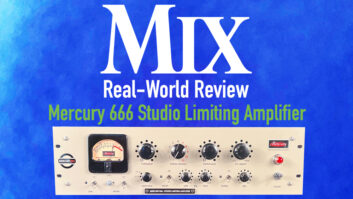
This month, I’m finally closing the book on my “Pedant in a Big Box” IT glossary series, and all I can say is, man, did this project balloon! What started out as a seemingly modest glossary of non-audio techie terms has grown into a list of hundreds of words embodying a crazy amount of research time.
But before we dive into the “W”s, I’d like to bring to your attention a development in EU policy-making that will have subtle but important implications for our industry. It begins with the dichotomy between one facet of Euro and U.S. public opinion, ends with those magic boxes that free many of us from being formal “engineers” and all comes down to heavy metal.
No, I’m not talking about the heavy metal genre of big hair and tight pants; I’m referring to the plumbic alloys used as solder in most electronic assemblies. You see, the EU, unlike us Yanks, is concerned about long-term public health and has phased in a “restriction of the use of certain hazardous substances in electrical and electronic equipment,” as the RoHS (Restriction of Hazardous Substances) document is subtitled. The Directive 2002/95/EC of the European Parliament and of the Council explicitly states, “Member States shall ensure that, from July 1, 2006, new electrical and electronic equipment put on the market does not contain lead, mercury, cadmium, hexavalent chromium, polybrominated biphenyls (PBB) or polybrominated diphenyl ethers (PBDE).”
Though this and another directive, WEEE, or Waste Electronics and Electrical Equipment, come out of the EU, Japan is also pushing ahead with “green” manufacturing initiatives, and any U.S. company conducting global business in the electronics, fastener (hexavalent chromium or Cr IV provides great corrosion resistance), jewelry or a host of other industries had better pay attention to stay competitive or will be shut out from lucrative European and Far East markets.
Fine and dandy, but why should we care? After all, if our government isn’t concerned with such trifling, why should we be? Well, two things, really: size and reliability. Let’s start with the latter. We have come to expect good reliability from pro-grade electronics, and I expect some interesting exceptions to that rule will surface in the next few years. The reason is that lead — which I mentioned earlier — or the lack thereof.
You see, electronic parts are attached to their circuit boards with an alloy of about 40 to 60 percent lead and other metals, often silver or tin. If you change the composition and remove the offending lead from electrical solder, then you raise the melting point to within a dozen degrees of the temperature, at which point, those precious components you’re attaching are literally cooked to death.
According to Canfield Technologies, a solder manufacturer, “Typical re-flow soldering temperatures for tin-lead alloys have a peak temperature of approximately 220° C. For lead-free alloys, the peak temperatures for re-flow soldering can be as high as 260° C.” This means that automated assembly processes must be fundamentally modified to achieve reliable solder flow and “wetting” without exceeding temperature limits. (See “Where’d I Put That Flux Capacitor?”)
To make matters worse, many integrated circuits, or ICs, will require either re-packaging or retirement. There might be some serious hand-wringing resulting from this directive. I see prices going up and reliability going down for several years as sweeping obsolescence removes the majority of electronic components from the supply chain, all to be replaced with higher temperature — tolerant, heavy metal — reduced versions. At the same time, some parts will simply go away, never to be manufactured again.
This isn’t the first time that a big change has happened in the electronics industry due to environmental concerns. In the mid-’80s, the elimination of ozone-depleting CFCs (chlorofluorocarbon solvents) caused a major upheaval in an attempt to find a solution to global warming. That crisis led to the rise of “no-clean” fluxes, which do not require removal after assembly, and water-soluble fluxes that replaced the noxious chemical solvents of days past.
In similar fashion, the electronics industry has introduced new tin/silver/copper (95.5 percent tin/3.9 percent silver/0.6 percent copper) and new compatible fluxes to ensure proper wetting and flow characteristics. The medical and food service industries have been using lead-free solders for more than a decade, so there is a small but significant body of historical data available on using lead-free products.
Way back at the start of this rant, I mentioned size. By that, I meant a temporary increase in size for some products as mechanical designs change to accommodate the increased temperature profiles of lead-free soldering or the size increases because one of the more highly integrated parts are no longer available. However, savvy engineers should be able to minimize this effect.
Oh yeah, there’s another fun fact relating to this hardware headache and it’s known as “tin whiskers.” I’ll leave it to you to Google the phrase and consider the implications of whiskers combined with the other reliability issues of the RoHS and WEEE directives, especially for the high-density packaging so common with surface-mounted ICs. Being Pb-free won’t be easy, but, thanks to the EU and the Japanese, our domestic disregard for environmental concerns that interfere with the smooth flow of money up the social ladder is being short-circuited in more ways than one.
OMas is enjoying a lead-free spring in sunny S.F. Recent revelations, besides the RoHS, include the low-maintenance Brit pop of Dogs Die in Hot Cars on the V2 label.
PEDANT IN A BIG BOX: PART NINE
THE LAST OF AN ONGOING SAGA OF NERDY NOMENCLATURE
Wire Speed: a code word for hardware-based, as opposed to software-based.
WLAN (Wireless LAN): A WLAN uses a wireless PHY.
WMA (Windows Media Audio): Microsoft’s family of codecs for packetized audio data. There are four members of the family: a general codec, a Professional version that supports 24-bit word lengths and multiple channels, a Lossless version and a Voice version that is optimized primarily for reproducing speech.
Workstation: a vague term that describes a complete personal computer of more than average capabilities. A professional version of a personal computer.
Worldwide Web, World Wide Web: Invented by Sir Tim Berners — Lee, the Web is a combination of ad hoc and proprietary technologies, applications and standards that provide multilingual, interoperable electronic delivery of text, hypertext and audio/visual content. The Web is based on two key systems: the Internet and the Web browser.
Wrapper: a file format that encapsulates a variety of metadata and essence into one package.
WWW (World Wide Web): See Worldwide Web.
xBASEy: the nomenclature for designating IEEE 802.3 or Ethernet cabling. The x is the design data rate — 10 through 10,000 Mbps — while the y refers to the cabling type or category. Categories include the original thick coaxial cable (BASE-5); the second-generation thin co-ax, or “Thinnet” (BASE-2); the original voice-grade UTP (BASE-VG); the more common, improved UTP (BASE-T) and BASE-F for glass fiber; and the PHY, capable of supporting the highest data rates of all cabling types.
Xerox PARC (Xerox’s Palo Alto Research Center): Founded in 1970, PARC is Xerox’s attempt to drive competition through innovation. An example of pure research yielding some impressive results, researchers at Xerox’s PARC were responsible for changing the face of modern personal computing, inventing — among other things — the graphical user interface, the computer mouse, “the Ethernet” and the laser printer. Despite the company’s valuable contributions, Xerox has never been able to capitalize on its PARC investment.
xML: SGML, the parent of all subsequent xML dialects, is a standardized language for describing, or “marking up,” a document’s appearance. SGML and its dialects separate the content from the document’s appearance. More recent standards include HTML, the Hypertext Markup Language used for Web pages; VRML, the Virtual Reality Markup Language used for “VR” delivery; SAML, the Security Assertion Markup Language used for identification and authentication; and XML, the Extensible Markup Language, which is used for Net services.
— OMas
WHERE’D I PUT THAT FLUX CAPACITOR?
What’s all this about wetting and flux? Flux is a blanket term used to describe various chemicals that remove contaminants during the soldering process. When plumbers fix a copper pipe, they use a highly reactive acid to chemically clean the pipe’s surface — like how detergent cleans greasy dishes — so the solder will “wet” and flow across the joint. As you may know, that acid flux would be the death of an electronic device: The flux would “clean” its way right thought the circuitry. In the world of electronics, clean metal makes for mechanically solid and highly conductive connections, while dirty pieces make for “cold solder joints” that are electrically and mechanically unreliable.
— OMas







